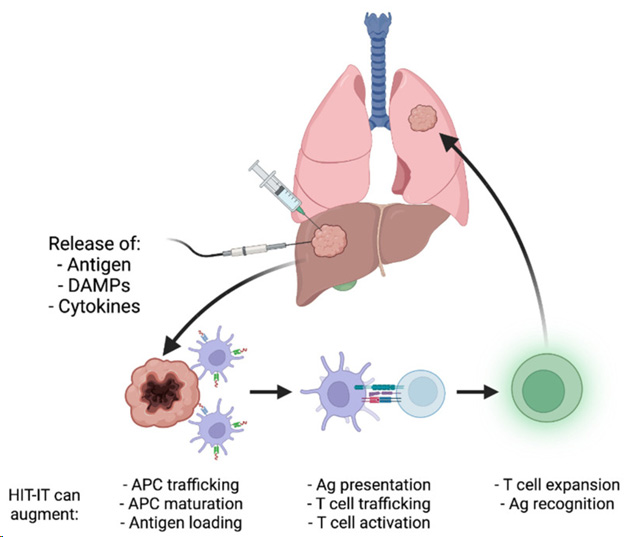Intra-tumoral Treatment
Intra-tumoral immunotherapy, the direct inoculation of immune stimulating agents into the tumor itself, has a number of features that make it particularly useful in the treatment of cancer. In this approach immune stimulating agents are injected directly into the tumor site, thus avoiding off-target toxicities and adverse effects that can accompany global immune stimulation. When this modality is used by itself, it may be helpful in only killing the tumor that the substances were injected in.
Ablation techniques, such as cryoablation, radiofrequency ablation, and microwave ablation, again, are techniques that attempt to kill the tumor that was treated, but are likely not helpful in treating the tumors that were not ablated.
Ablative techniques vary in mechanism; however, their therapeutic efficacy is primarily achieved via local tumor destruction. Ablated tumor tissue is subsequently left in situ where inflammatory mediators, damage-associated molecular patterns (DAMPs), and other immunomodulatory factors are released. Importantly, there is a large source of tumor antigen that remains in situ and available for processing by antigen-presenting cells. Unfortunately, the immunostimulatory effect of ablation alone is generally insufficient to produce a durable antitumor immune response. This has prompted interest in enhancing the immune effects of ablation by combining it with intra-tumoral immunotherapy.
Using ablation to a tumor to release inflammatory mediators, damage-associated molecular patterns (DAMPs), and other immunomodulatory factors, followed by immediately injecting immunotherapy agents into the tumor, has often shown to results in an abscopal effect (tumor regression of both the target lesion and any untreated tumors).

https://www.ncbi.nlm.nih.gov/pmc/articles/PMC8996835/
This pictorial is represents ablating the primary tumor followed by direct injection of immunotherapy substances. Early studies look promising.
At Advanced Medical Therapeutics, we work closely with Curtis Anderson, M.D., PhD, who is an extremely talented Interventional Radiologist, with significant experience in combining cryoablation with intra-tumoral immunotherapy. His success in treating metastatic pancreatic cancer is particularly remarkable.



